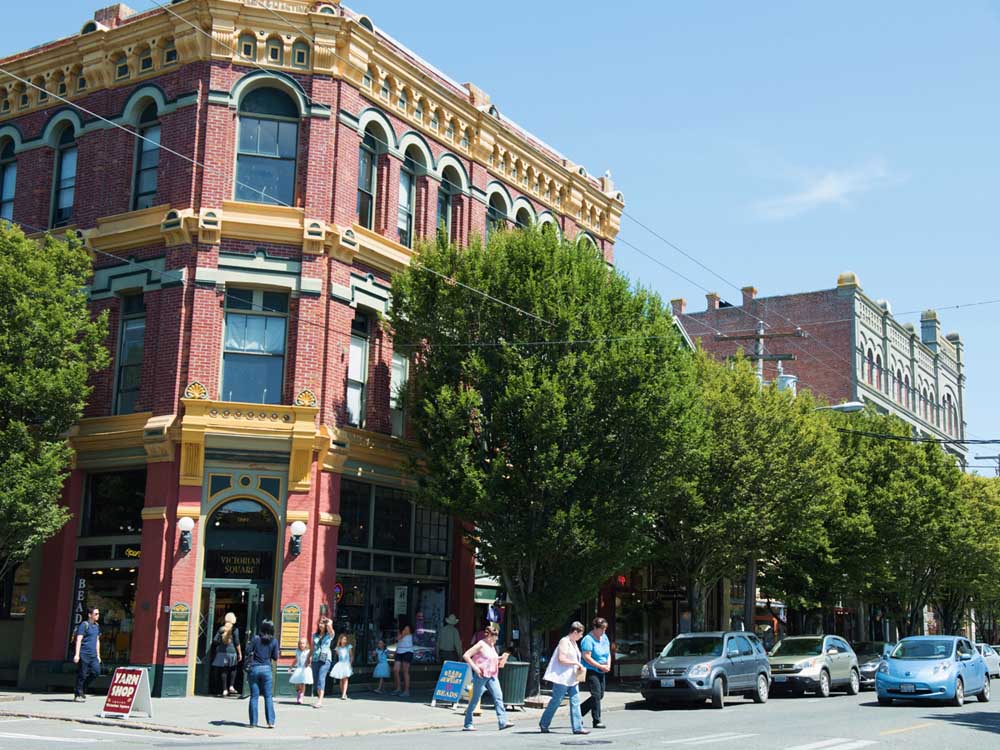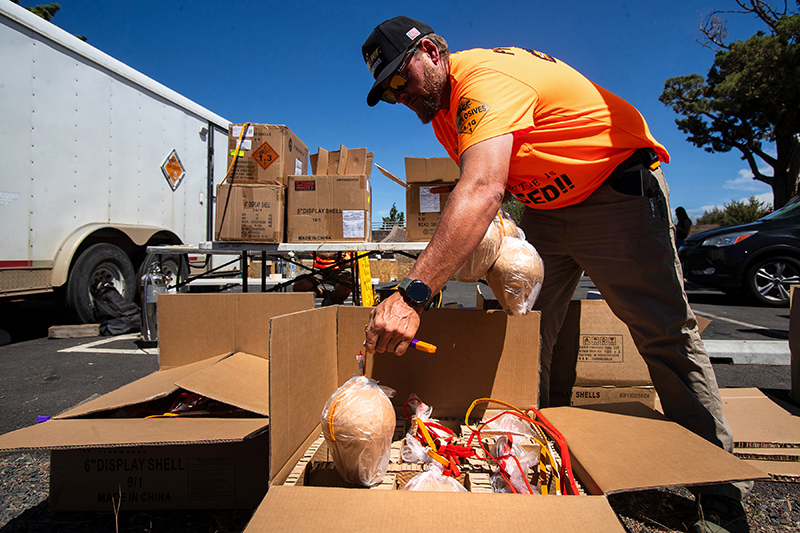The Northwest’s Victorian Seaport
Published 12:00 am Sunday, August 2, 2015

- Barb Gonzalez / For The Bulletin The elegant main thoroughfare of downtown Port Townsend, Water Street, is lined for six blocks with buildings mostly dating from the 1880s. This view looks north from the beautifully restored James and Hasting Building, constructed in 1889.
PORT TOWNSEND, Wash. —
Even though the hotel is set a block back from Water Street — the traditional main street of this maritime community — The Bishop Victorian Inn typifies the atmosphere of historic Port Townsend.
A three-story brick structure built in 1891, the Bishop is an integral element in the chronicle of the port town, located at the most northeasterly point of the Olympic Peninsula.
It dates from a time when city fathers believed Port Townsend would become the greatest port in the Pacific Northwest, a city to equal or even surpass San Francisco. One city founder, in the early 1850s, had publicly labeled it “the New York of the West.”
Alas, it was not to be. Despite a concerted effort at building a grand and glorious harbor town — no fewer than 49 structures still stand from the mid-1890s and earlier — the coveted Pacific coast railroad bypassed Port Townsend in favor of Seattle and Tacoma, on the east side of Puget Sound.
Dreams shattered with the economy.
The town didn’t disappear completely. Within a decade, already hearing the distant whispers of the First World War, the U.S. Army established Fort Worden on the strategic headland where Puget Sound meets the Strait of Juan de Fuca. Between 1902 and 1953, some 400 buildings, including numerous artillery batteries with guns pointed out to sea, were constructed on the bluffs a couple of miles north of downtown.
Not a single wartime shot was fired, not in World Wars I or II. But the presence of Fort Worden provided the stability Port Townsend needed to regroup. And today, that is a certain boon for tourism: The town appears much as it did in the late 19th and early 20th centuries.
Granted, there are changes, notably the beautiful new Northwest Maritime Center beside Point Hudson Marina, the town’s small boat harbor. But six blocks of Water Street are still lined with three-story buildings from the 1880s, and the jail beneath City Hall hasn’t changed much since the night that aspiring author Jack London spent there, before shipping out for the Klondike Gold Rush (inspiring his novel, “The Call of the Wild”).
Days of yore
You’ll know the Bishop Victorian immediately from its distinctive ink. The tall brick building stands alone, a garden on one side, a gravel parking lot on the other, so that its “Owl Cigars” tattoo is clearly visible on its northeast wall from blocks away. Like much of the turn-of-the-last-century commercial advertising in this town, it has been carefully preserved.
So has the hotel itself. Erected by a multi-talented British sailor named William Bishop, it’s a fine example of an era without elevators. From a ground-level door outside the lobby, 26 steep steps ascend to the second-story guest rooms. And if you are blessed with a third-story room, as I was on my recent visit, there are 18 more stairs to climb.
My chamber was absolutely charming. Furnished with Victorian-era antiques, from the queen bed to the sofa and armoire (but not including the TV). I almost felt as though it could have been a century earlier. Until the guttural chants filtered up from Memorial Field, across Quincy Street.
I sense that high school football might play a bigger part in the lives of modern youth than it did in the distant past. My July visit coincided with three-a-days that continued under the lights until after 10 at night. By the time helmets and shoulder pads had been retired for the evening, other revelers were departing the Water Street bars, their raised and slightly slurred voices carrying well beyond the range of normal conversation.
But, one could argue, this was in keeping with the rowdy harbor-town ambiance into which Port Townsend was born.
The heart of Water Street and its side lanes are rife with well-preserved memories. Quaint hotels like the Palace, the Belmont and the Swan, as well as the Bishop, recall the days of yore. Shops and galleries — including my personal favorite, the marvelous (and author-oriented) Imprint Bookstore — cater to all tastes. The selection of restaurants exceeds expectations for a town of 9,100; the Alchemy Bistro & Wine Bar, the Fountain Café and the Silverwater Café all are fine choices for creative gourmet cuisine.
Climb the steep steps to the Siren Pub — two more precipitous flights, and you’ll begin to appreciate why townsfolk have strong quadriceps muscles — and you’ll be treated to a fine view across Port Townsend Bay, toward adjacent Marrowstone Island, as you enjoy your fish and chips with a local IPA.
But that’s in the afternoon or early evening hours. Later at night, there may be music or a raucous comedy routine that gets the crowd pumped. A similar scene could take place at the Belmont Saloon or the Cellar Door, both of whose spaces date from 1889, or several other watering holes around town.
Harbor life
In the first hours after dawn, I find myself drawn to the sails and masts at Point Hudson where Water Street comes to an end beside the Northwest Maritime Center. Beyond the harbor, looking past the decommissioned Point Wilson lighthouse toward Whidbey Island a few miles distant, buoy bells ring in the morning breezes and kingfishers laugh like kookaburras at yellow kayaks that glide past tidal flats. Dozens of fishing boats have already lowered anchors as they await a major run of coho salmon.
Since 1977, Port Townsend has been renowned throughout the West for its annual Wooden Boat Festival, held the weekend after Labor Day in September. About 30,000 boat lovers attend the event. Some 200 hand-crafted vessels are displayed in the marina. Many of them have permanent homes in the slips.
Restaurants and an RV park share some of the harborside area, but so do maritime industries — among them a boat kit manufacturer (Pygmy Boats), a whale-watching cruise operator and a pair of internationally renowned marine craftspeople. The shops of sail-maker Carol Hasse and rigger Brion Toss stand one atop the other facing the harbor on its west side.
Brian Toss Yacht Riggers have also been around since 1978, training sailors in knots and hardware, ropes and climbing harnesses. Hasse, who has been in her loft since the first Wooden Boat Festival, is internationally renowned for her durable and lightweight Dacron mainsails, spinnakers and other sails. Hasse & Co. invites respectful visitors to observe the process by which its all-women team designs, cuts, sews and finishes the products. The company is presently working on a 12-month backlog with demands from as far away as Italy.
The heart of Port Townsend’s downtown waterfront is the $16 million Northwest Maritime Center and Wooden Boat Foundation. Opened in September 2009, it has classrooms and a conference center, an art gallery and a marine library, a coffee shop, a gift shop and a storage facility for rowing shells. Most significantly, it includes a demonstration boat shop, where craftsmen can be engaged in conversation as they design and construct wooden boats.
In fact, craftspeople come to Port Townsend from all over the world to learn the art of boat-building, both here and at the NorthWest School of Wooden BoatBuilding in Port Hadlock, 8 miles south. There, too, visitors may converse with instructors and perhaps register for classes. Just across the road, the Ajax Café is an outstanding place for dinner.
Near the main highway entrance to Port Townsend, Boat Haven is the workingman’s harbor. Developed in the 1960s and ’70s, the port has a 300-ton lift that assures dozens of boats may be out of the water for restoration at any given time. A walk or slow drive through this industrial area reveals a wide variety of shipwrights at work: welders, electricians, plumbers, woodworkers and others. During my recent visit, the “Lady Washington” tall ship, normally moored in Grays Harbor, was undergoing repairs.
Fort Worden
Even though it was decommissioned in the 1950s, Fort Worden remains a major attraction. A Washington state park since 1973, the 434-acre property has a main campus on its southeastern side, focused upon The Commons, a gathering place with a casual café and dining hall, two historic museums, the Commanding Officer’s Quarters and the Puget Sound Coast Artillery Museum.
The acclaimed Centrum program, now in its 42nd season, is based here; participants from all over the world immerse themselves in a June-through-October season of literary, dance and musical programs, highlighted by blues, jazz, fiddle and ukulele festivals.
There’s also a theater and concert pavilion, a school of woodworking, an alternative medicine provider, one of the nation’s largest publishers of poetry (the Copper Canyon Press), campgrounds, guest lodging on houses and youth hostels, tennis courts, and Chinese and rhododendron gardens. The Port Townsend Marine Science Center is a popular attraction for schoolchildren.
But some of the most remarkable attractions are outside of the main campus area, on and around Artillery Hill. The old gun emplacements are long since abandoned, but 12 miles of foot and bicycle paths wind past and even through them, affording glimpses of dank tunnels and dark chambers now frequented only by the swallows that nest within.
— Reporter: janderson@bendbulletin.com








